#central atlas tamazight
Explore tagged Tumblr posts
Text
Meteor Airlines - Warru (ⵡⴰⵔⵔⵓ) (Central Atlas Tamazight?) Recommended by @myceliumromance - thank you!!
#anthemy folk rock#meteor airlines#warru#ⵡⴰⵔⵔⵓ#central atlas tamazight#tamazight#ⵜⴰⵎⴰⵣⵉⵖⵜ#tzm#berber#afroasiatic#africa#morocco#2020#2020s#rock#request#i am not sure what variety of tamazight this is but i took a stab#what language is this?
1 note
·
View note
Photo

Tashelhit speakers in Morocco
According to the 2014 Morocco population census, there are around 9 million Tamazight(Berber) speakers in Morocco or 26% of the population.
by african.mapper/instagram
Tashelhit is the most widely spoken Amazigh language the world with more than 5 million native speakers. Central Atlas Tamazight is the second most spoken Amazigh language in the kingdom with around 3 million speakers. Tarifit, a Zenati Berber language spoken in the Rif region, is spoken by around 1.5 million Moroccans.
56 notes
·
View notes
Text
30 DE AGOSTO, 26 ANIVERSARIO DEL DÍA MUNDIAL DE LA BANDERA (ukenyal) AMAZIGH.
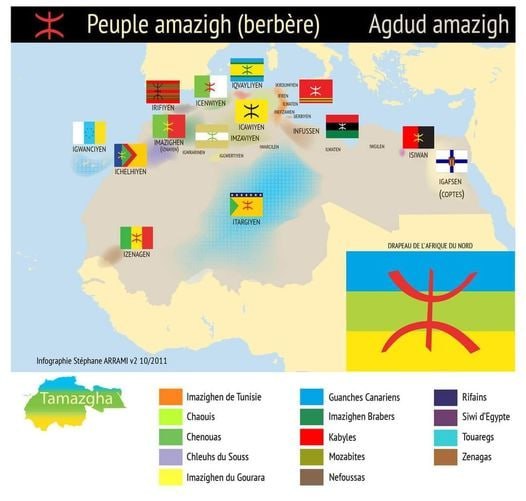
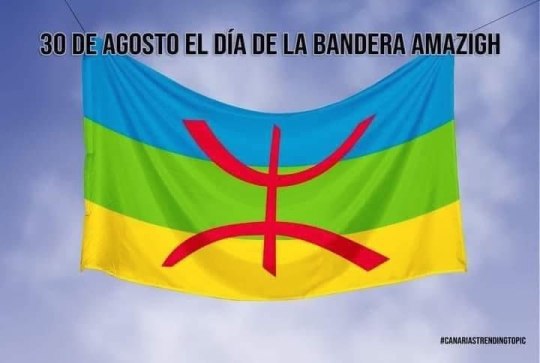
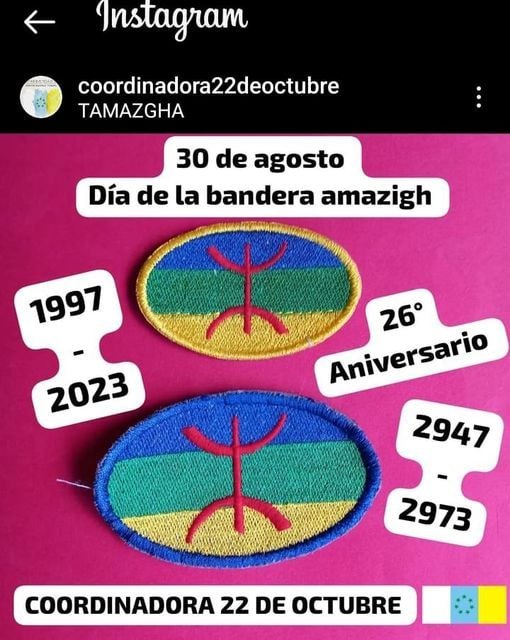

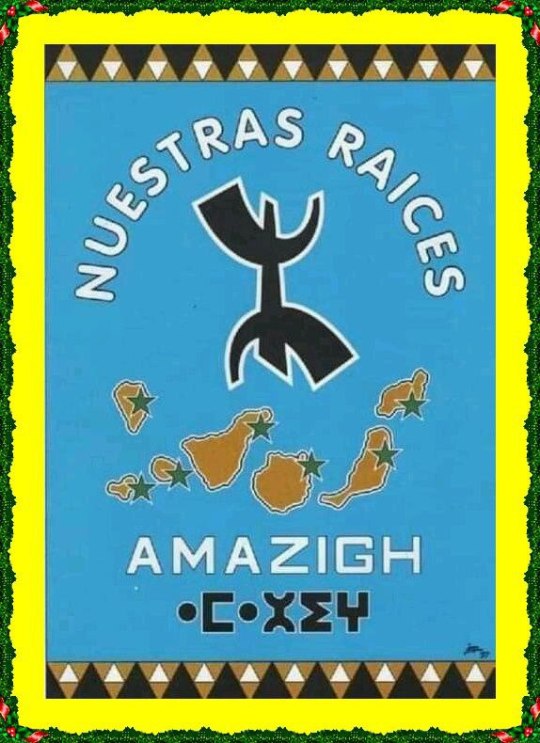
ⵣ✊🏼ⵣ ¡Feliz día
de la bandera Amazigh!
¡Viva la libertad de la Tamazgha
y de todos los pueblos imazighen!
ⵜⴻⴷⴰⵔⴰ ⵜⴰⵎⴰⵣⴳⴰ ⵜⵉⵍⴻⵍⵍⵉⵜ!
ⵀ★☆★ ☆ ★☆★
26 Aniversario del DÍA MUNDIAL
de la BANDERA (ukenyal) AMAZIGH.
ⵣⵣⵣⵣⵣⵣⵣⵣ
26º Amulli, Congrès Mondial Amazigh (CMA) - en Tamazight-.
ⵀ★☆★ ☆ ★☆★ⵀ
Cada 30 de Agosto, a raíz del Congreso Mundial Amazigh celebrado en Tafira (Las Palmas de Gran Canaria) en 1997, se celebra en todo el Mundo el nacimiento de este símbolo de unidad y libertad de los diferentes pueblos que viven en diversas regiones del norte de África (Territorio conocido como la Tamazgha) que comparten raíces culturales y lingüística comunes.
La bandera de nuestra identidad representa nuestra historia y nuestra lucha, une a todos los imazigen del mundo, y a los pueblos del norte de África: desde Siwa hasta Canarias, desde el mediterráneo hasta el río de Senegal (Tamazgha)
Los canarios, como uno de los pueblos imazighen más antiguos, lideramos, en ese Congreso histórico, la unificación de la Tamazgha y la creación de su bandera identitaria .
Los pueblos Amazigh han resistido y perdurado durante milenios, invasiones y colonizaciones incesantes (griegos, romanos , árabes... Y en la etapa moderna , europeos -franceses y españoles principalmente- y "yankees")
ⵀ★☆★ ☆ ★☆★ⵀ
La bandera Amazigh, representa la armonía de los seres humanos con su tierra.
El símbolo del hombre en rojo tiene un carácter antropomórfico, con forma humana, y ha sido conocido desde tiempos prehistóricos.
Su significado actual simboliza al pueblo Amazigh. Usado oficialmente desde que en 1966, Mohand Arav Bessaoud, fundara la Academia Amazigh .
ⵀ★☆★ ☆ ★☆★ⵀ
COLORES:
Simbolizan la costa norte de África con el Mediterráneo, el Atlántico con Canarias al Noroeste y el desierto del Sahara al sur, y su apego y su amor a su tierra.
Tienen los siguientes significados:
ⵣ☆ Banda superior azul (Amidad) : representa el mar Mediterráneo y el océano Atlantico, la costa imazighen durante milenios.
ⵣ☆ Banda central verde (Azegzaw) : significa la naturaleza y las grandes montañas (cordillera del Atlas) y tierras verdes que los imazighen han cultivado desde tiempos prehistóricos.
ⵣ☆ La banda inferior amarilla (Awragh) :
simboliza la arena del Sáhara, del desierto de la TINIRI la zona de los Tuareg, pero también la alegría y el oro o la riqueza.
ⵣ☆ El signo de la figura, a su vez, es la letra sagrada "Z" (Yas o aza) del alfabeto tifinagh (idioma Tamazigh)
En rojo, porque representa el color de la vida, pero también el color de la resistencia.
En la bandera representa el nombre dado a los Amazigh: "personas libres", que es lo que significa Amazigh (plural Imazighen).
Es el principio de vida eterna y un símbolo de la sangre de los mártires por la libertad, que defendieron y defienden su cultura y su tierra ante el colonialismo conocido (delito de lesa humanidad imprescriptible).
ⵀ★☆★ ☆ ★☆★
La bandera fue propuesta por la delegación canaria(¹), durante el Primer Congreso Mundial Amazigh, realizado los días 27, 28, 29 y 30, prolongádose hasta el 31 de Agosto de 1997 .
Al congreso acudieron representantes de los distintos pueblos del ámbito amazigh: Canarios, Rifeños, Tuaregs, Númidas, Kabilios, Chleuhs, Mozabíes Imazighen del Atlas, Soussa, Chausis, y también la diáspora amazigh estabilizada en Europa y América del Norte.
(¹) Jaime Sáenz Peñate (QPD) y Francisco Trejo Herrera , representantes de Solidaridad Canaria (S.C.) en el comité organizador, ante la ausencia de un símbolo que unificara a este pueblo milenario, con costumbres y lengua ancestrales con raíces comunes en la La Tamazgha (Norte de África) decidieron plantear en esa Primera Asamblea General, la creación de la bandera .
Se basaron en la primera propuesta oficial para que el pueblo Amazigh tuviera su propia bandera, que se hizo en el año 1971 en Roubaix (Francia) por Agraw Imazighen de la Kabilia ,como muestra cultural y de identidad.
ⵀ★☆★ ☆ ★☆★
Con mucha ilusión y éxito, fue acogida como un símbolo que , dese aquel momento, une a la comunidad Amazigh de todo el Mundo.
#bandera amazigh#amazigh#tamazgha#afrique#africa#berbere#aboriginal#aborigenous#indigenous#culture#history#genocide#native#unesco#united nations#canary islands#international criminal court#cou penal international#corte penal internacional#indígenas#aborigenes#cultura#historia#genocidio#nativos#naciones unidas#islas canarias#canarias tiene identidad cultural propia#canarias la colonia mas antigua del mundo#descolonizacion de canarias
25 notes
·
View notes
Text
Languages of the world
Standard Moroccan Tamazight (ⵜⴰⵎⴰⵣⵉⵖⵜ/Tamaziɣt)
Basic facts
Number of native speakers: 4.7 million
Official language: Morocco
Language of diaspora: France
Script: Neo-Tifinagh, 33 letters/Latin, 35 letters
Grammatical cases: 0
Linguistic typology: fusional, VSO
Language family: Afro-Asiatic, Amazigh, Kabyle-Atlas Amazigh, Atlas Amazigh, Central Moroccan Amazigh
Number of dialects: 3
History
1994 - beginning of the teaching of Amazigh languages in Morocco
2001 - creation of the Royal Institute of Amazigh Culture
2003 - Neo-Tifinagh becomes the official script for Tamazight
Writing system and pronunciation
These are the letters that make up the Neo-Tifinagh script: ⴰ ⴱ ⴳ ⴳⵯ ⴷ ⴹ ⴻ ⴼ ⴽ ⴽⵯ ⵀ ⵃ ⵄ ⵅ ⵇ ⵉ ⵊ ⵍ ⵎ ⵏ ⵓ ⵔ ⵕ ⵖ ⵙ ⵚ ⵛ ⵜ ⵟ ⵡ ⵢ ⵣ ⵥ.
These are the letters that make up the Latin alphabet: a b c č d ḍ e ɛ f g ǧ ɣ h ḥ i j k l m n o q r ř ṛ s ṣ t ṭ u w x y z ẓ.
The only official script is Neo-Tifinagh, but the Latin and Arabic ones are also widely used.
Stress falls on the last vowel in a word.
Grammar
Nouns have two genders (masculine and feminine), two numbers (singular and plural), and no cases. They can also be put into two states depending on whether they indicate possession, free or construct.
Pronouns appear in three forms: an independent form used as the subject, a possessive suffix, and an object form affixed to the verb. Prepositions may also take pronominal suffixes.
Verbs are conjugated for tense, mood (horatory, imperative, and normal), gender, number, and person. Subject markers are circumfixed to the verb.
Dialects
Standard Moroccan Tamazight was created by combining Shilha, Central Atlas Tamazight, and Riffian. The differences between them are mainly phonological and lexical.
All Shilha varieties are mutually intelligible. Central Atlas Tamazight dialects can be further subdivided into those spoken in the Middle Atlas mountains, those of the High Atlas mountains, and those spoken in Jbel Saghro. Riffian includes West-Riffian, Central-Riffian, and East-Riffian.
74 notes
·
View notes
Photo
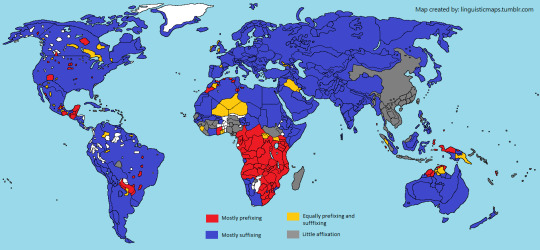
Prefixing and suffixing languages
Mostly prefixing - Most Berber languages, Bantu languages, Guarani, many Macro-Ge languages, Mayan languages, Oto-Manguean, Mixtec, Siouan, Navajo and many Na-Dene languages, some languages in northwest Papua and northwest Australia.
Mostly suffixing - Indo-European, most Afro-Asiatic, Turkic, Mongolic, Dravidian, Austronesian, Northeast Caucasian, Eskimo-Aleut, Uralic, Koreanic-Japonic, most Pama-Nyungan languages.
Equally prefixing and suffixing - Cree, Ojibwe, O’odham, Tarahumara, Pilagá, Carib, Central Atlas Tamazight, Tuareg, Iraqi Arabic, Zande, Krio languages, Ewe, Toba, many languages in east Papua-New-Guinea, Basque, Nortwest Caucasian, Celtic.
Little affixation - typical of isolating languages, in Sino-Tibetan, Austroasiatic, Hmong-Mien, Nilo-Saharan, Mande, languages of West Africa, many Austronesian languages.
Based off and simplified from: https://wals.info/feature/26A#2/22.6/153.1
307 notes
·
View notes
Text
I thought to compare some numbers across the Berber languages to see if I could get at anything Afroasiatic. I’ve never really done a serious reconstruction but this is kind of fun and I thought I’d just share for the hell of it. Most of them seem to have borrowed Arabic’s numbers, and a few I couldn’t find good resources on, so with what I have
(All numbers are given from one to ten, top to bottom) Central Atlas Tamazight
* yan
* sin
* kṛaḍ
* kkuẓ
* smmus
* sḍiṣ
* sa
* tam
* tẓa
* mraw
Kabyle
* yiwen
* sin
(Arabic)
Tecelħit (Shilha)
* yan
* sin
* kraḍ
* kkuẓ
* smmus
* sḍis
* sa
* tam
* tẓa
* mraw
Tarifit (Riffian)
* yiwn
* snen
(Arabic)
Zenaga
Source used French spelling, was old.
* yun
* šnen
* karat
* akoz
* šammuš
* šaduš
* išša
* ittem
* tuza
* mereg
Siwi
* ǧən
* sən
(Arabic)
Ghadamsi (-mès)
* yon
* sən
* karăḍ
* aqqoz
* səmməs
(no numbers greater than 5 given)
Tuareg/Tamahaq
* iyen
* essin
* karad
* okkoz
* semmus
* sedis
* essa
* ettam
* tezza
* meraw
(It’s typical in Berber contexts to spell /ə/ e if it isn’t just left unwritten)
Ghadamsi, Zenaga, Tarifit, and Kabyle seem to point to a back element in the one number, and most seem to evidence a Berber schwa before n, so *iwen seems logical.
Seems to be almost perfect agreement towards *sin for two. the *snen form is likely an issue of which form was chosen for citation, with that being a declined masculine form and not the counting number.
Three is less well attested. There seems to be agreement towards krad, with an emphatic element attested twice on the d, and only once on the r (which is likely contamination, because emphaticness likes to spread). so *keraḍ
Four invariably starts on a vowel, and the few languages where it’s characterized I’ve read have histories of vowel harmony. The original vowel was probably e, all but Zenaga point to a geminate k, u is likely given Berber languages tending to a/i/u/e systems in general, and from Ghadamsi’s q and Shilha’s z point to an emphatic element somewhere. Zenaga and Tamahaq point to the q being k, so z being emphatic, but I’m not really sure either reconstruction is really justified. For now, *ekkuẓ
Five seems pretty constantly *semmus. The vowel reduction in Ghadamsi and Zenaga’s backing don’t really need explaining, especially since my source wrote ch consistently for whereever s was in other reconstructions.
Six has the same form in Tamahaq and Shilha, and only CATamazight shows ṣ for the final radical. Zenaga’s vowels deserve some explanation, but I don’t really have enough information to do that. Egyptian’s sjsw and Semitic’s *saḍþ (no theta, sorry) seem to point six being an established basic AA word (at least within their subclades), so the d is probably emphatic. Again though the a is likely VH. *seḍis , maybe *seḍus
Tamahaq and Zenaga show an initial e where the Northern Berber languages don’t. *sa or *essa seem to be the options given from my set.
Same situation for eight, *tam or *ettam
Where Tamahaq and the northern languages show a schwa in nine, Zenaga shows a back vowel, probably evidencing against the *u in six too. More ambiguous is the state of the emphatic. *teza or *teẓa
Finally in ten, only Zenaga through French seems to show g, and w > gh is regionally common. More have w than don’t and otherwise agree on the word form, so we have *meraw
So, possibly, from this extremely limited dataset with no formal training or any idea of what I’m doing, I got
*iwen
*sin
*karaḍ
*ekkuz
*semmus
*seḍis
*essa
*ettam
*teẓa
*meraw
Which is remarkably close to Tuareg/Tamahaq.
Compared to Egyptian and Semitic, 2 seems close to Egyptian’s snwj and might be a reflex of an original AA word like *tsan, which might have yielded *þan for Northern Semitic. 6, 7, 8, and 9 look like the Semitic numbers. 5 almost looks like xams- for Semitic, but I don’t think there’s anything that can really be extrapolated to a common ancestor from that because I don’t think that’s a systematic correspondance. Something similar is happening in Egyptian’s 8 - xmnw is reconstructed by some to be *xamaan-aw, including a long vowel in the mn element, which is somewhat similar to the þamaaniy reconstruction for Semitic. Especially if you throw in the mess where y/w seem to be mixed regularly in these languages, such as Hebrew/Arabic yaħid/waħid
2 notes
·
View notes
Photo

Looking for some super fierce jewelry, small wrist ladies? This pair of spiked Old Berber bracelets Asbia' Iquorain from the Ait Atta Tribe just may fit the bill. The Ait Atta are a large Berber tribal confederation of South eastern Morocco. They are divided into “five fifths” (khams khmas), all said to descend from the forty sons of their common ancestor Dadda Atta: these “fifths” are the Ait Ouallal, Ait Ouahlim, Ait Isfoul, Ait Yazza and Ait Ounbgi. They speak Central Atlas Tamazight. The Ait Atta originated as a political entity in the Jbel Saghro region in the 16th century with the founding of their traditional capital Igherm Amazdar. Swipe to see a photo of an Ait Atta wearing a similar pair. Follow the tag to shop ours. #berber #berberjewelry #berberbracelet #spikedbracelet #aitatta #aitattatribe #moroccan #moroccanjewelry #moroccanbracelet #vintagejewelry #vintagebracelet #vintageberberjewelry #tribaljewelry #fiercejewelry #smallwristbracelet #wonderwoman #fashion #style #styleinspo #shop #nyc #unionsquare #beadsofparadise (at Beads of Paradise NYC) https://www.instagram.com/p/CYpItfkv0Ea/?utm_medium=tumblr
#berber#berberjewelry#berberbracelet#spikedbracelet#aitatta#aitattatribe#moroccan#moroccanjewelry#moroccanbracelet#vintagejewelry#vintagebracelet#vintageberberjewelry#tribaljewelry#fiercejewelry#smallwristbracelet#wonderwoman#fashion#style#styleinspo#shop#nyc#unionsquare#beadsofparadise
0 notes
Photo
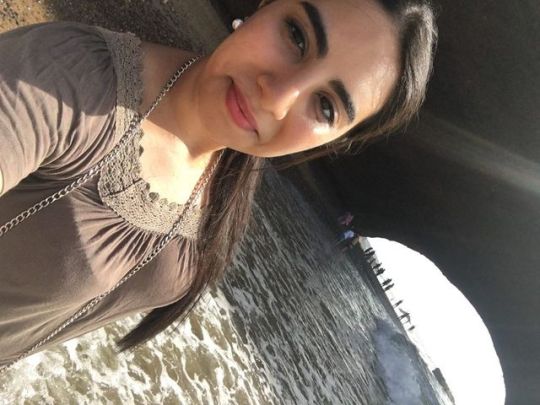
📍Provincia de Sidi Ifni ⵎⵉⵔⵍⴼⵜ (Central Atlas Tamazight) 🌃Mirleft Beach 🏝 🏖 “Nadie se da cuenta de lo hermoso que es viajar hasta que vuelve a casa y descansa sobre su almohada vieja y conocida”. – Lin Yutang 📝📝🔖#sidi #ifni #city #mirleft #mirleftbeach #playa #mirleftmaroc #beachday #holidays #holi #enjoy #summer #provence #holiday #another #city #citylife #citylights #lovely #blogger #video #post #instagram #fac #social #media #travel #travelblogger #ñ 🤗🌌🌃🌉📷📷 (at Mirleft ⵎⵉⵔⵍⴼⵜ) https://www.instagram.com/p/B0TAQwuB_Zs/?igshid=1eungcsd7ww3i
#sidi#ifni#city#mirleft#mirleftbeach#playa#mirleftmaroc#beachday#holidays#holi#enjoy#summer#provence#holiday#another#citylife#citylights#lovely#blogger#video#post#instagram#fac#social#media#travel#travelblogger#ñ
0 notes
Photo

Moroccan Darija (الدارجة) is a language derived from a variety of Arabic spoken in Morocco. It belongs to the Maghrebi Arabic language continuum and is mutually intelligible, to an extent, with Algerian Arabic and to a lesser extent with Tunisian Arabic. It shows very strong historical and linguistic Berber, French, and Spanish influences. Standard Arabic, not spoken in daily life, is used for official communications by the government and other public bodies, while Moroccan Darija has a strong presence in TV, cinema, and advertising and is the most spoken language in daily life.
Morocco’s official languages are Arabic and Berber. The country’s distinctive group of Moroccan Arabic dialects is referred to as Darija. Approximately 89.8% of the population can communicate to some degree in Moroccan Arabic. The Berber language is spoken in 3 main dialects (Tarifit, Tashelhit, and Central Atlas Tamazight). In 2008, Frédéric Deroche estimated that there were 12 million Berber speakers, making up about 40% of the population.
131 notes
·
View notes
Text
Morocco guide: 10 things to know before you go
(CNN)Rainbows of color, spice-market smells, an urban orchestra of sounds: Morocco can be overwhelming at first.
Lying 13 kilometers, or 8 miles, from the coast of Spain, the North African country mixes Middle Eastern magic, Berber tradition and European flair.
Tourism has more than doubled since 2002, to nearly 10 million visitors in 2011. King Mohammed VI wants to increase the annual visitor numbers to 18 million by 2020.
The royal ruler’s strategy is underpinned by infrastructure development, making traveling around the country even easier.
Add to this a program of ongoing social, political and economic reforms, and Morocco is one of the most moderate and peaceful countries in the region.
Here are 10 things you’ll want to know before you arrive:
1. Cafes dominate life in Tangier.
Cafes are the key place to socialize, for Moroccan men at least. They gather to drink sweet mint tea and watch people as they go about their affairs.
The northern port city of Tangier has a history of literary bohemianism and illicit goings-on, thanks to its status as an International Zone from 1923 to 1956.
The Interzone years, and the heady decades that followed, saw writers, rock stars and eccentrics flock to the city’s 800-plus cafs.
Two must-visit spots: Cafe Hafa (Ave Hadi Mohammed Tazi), overlooking the Strait of Gibraltar, was a favorite hangout of Tangier’s most famous expat, writer and composer Paul Bowles.
Smoky and slightly edgy, Cafe Baba (1 rue Sidi-Hosni) is the coolest spot in the Kasbah. A photo of Keith Richards, kif-pipe in hand, still adorns the grimy walls.
Sea, souks and surfs in Morocco
2. Most mosques are off-limits to non-Muslims.
Nearly 99% of the population is Muslim, and hearing the muezzin’s melodic call to prayer for the first time is a spine-tingling moment.
While very few Moroccan mosques are open to non-Muslims, one exception is the towering Hassan II Mosque in Casablanca (Blvd Sidi Mohammed Ben Abdallah; +212 522 22 25 63).
Located on a promontory over the Atlantic Ocean, the mosque was completed in 1993 and can hold 105,000 worshipers inside and out.
Tradition and technology sit side by side, with colorful zellij (mosaic tiles), intricate stucco and carved cedar complementing the retractable roof and heated flooring.
If you can’t make it to Casa, Marrakech’s 16th-century Ali ben Youssef madrassa-turned-museum (Pl Ben Youssef; +212 524 44 18 93) is open to all and also features impressive Islamic design.
3. Multilingual Moroccans will put you to shame.
Moroccans switch languages mid-sentence, reflecting the cultures — Berber, Arab, French and Spanish — that have crisscrossed the country.
Arabic is the official language, and you’ll hear the Moroccan dialect, Darija, spoken on the street.
French continues to be widely spoken in cities; foreigners are often addressed in this first. Spanish is still spoken in Tangier.
There are also three main dialects spoken by the country’s Berber majority: Tashelhit, Tamazight and Tarifit.
You’ll be able to get by with English in the main tourist hubs, although “La, shukran” (“No, thank you” in Arabic) is one phrase to master.
4. Don’t get stuck in Marrakesh.
Marrakesh is justifiably popular, but there’s so much more.
Fez tops the list for its maze-like medina, fabulous foodie scene and annual Festival of World Sacred Music.
For a slice of the Sahara, there’s the desert town of Merzouga, near the impressive Erg Chebbi sand dunes, accessible via camel treks.
Active types can hike between Berber villages in the High Atlas or head to the blue-hued Andalusian town of Chefchaouen to explore the Rif Mountains.
Beach bums will love laid-back Essaouira and Sidi Ifni on the Atlantic coast, while surfers often head south to Taghazout.
For quiet contemplation, Morocco’s holiest town, Moulay Idriss, is hard to beat. Plus, you’ll have the nearby Roman ruins of Volubilis pretty much to yourself.
The Atlas Mountains: Morocco’s hidden travel gem
5. If you don’t like cumin, you may starve.
Cumin is one of the main spices used in Moroccan cooking. This pungent powder is used to flavor everything from tagines to mechoui (slow-roasted lamb).
Cumin is used as a condiment on most Moroccan tables, along with salt and chili. It’s also a popular natural remedy for diarrhea.
“Cumin has anti-parasitical properties, so if you’ve got an upset tummy, a spoonful of cumin knocked back with water will help,” said food guide Gail Leonard with Plan-It Fez.
10 street foods to try in Morocco
6. Trains are cheap, comfortable and reliable.
Train company ONCF operates one of the best train networks in Africa, making it the easiest way to travel between cities.
It’s worth paying extra for first class, which comes with a reserved seat and A/C.
First class carriages have six-seat compartments or open-plan seating. Stock up on snacks, or buy them onboard, as it’s customary to share food.
When it comes to traveling to smaller towns and villages, buses and grand taxis, usually old Mercedes sedans that can seat six (at a squash), are best.
7. Couscous is served on Fridays.
You’ll see it on every restaurant menu, but traditionally, couscous is served on Fridays, when families gather after prayers.
This is because the proper (not packet) stuff takes a long time to prepare.
Coarse semolina is hand-rolled into small granules to be steamed and fluffed three times. It’s pale in color, deliciously creamy and served with vegetables and/or meat or fish.
Bread is the staple carb and is served with every meal, except couscous.
It’s baked in communal wood-fired ovens, one of five amenities found in every neighborhood (the others being a hammam, or bathhouse; a drinking fountain; a mosque and a preschool).
8. Riad rooftops rock.
The traditional Moroccan house (riad) is built around a central courtyard with windows facing inwards for privacy.
They’re decked out with elaborate zellij, stucco and painted cedar and are easily the most atmospheric places to stay.
While Moroccans tend to use their rooftops as clotheslines, a riad roof terrace is the place to be come sunset.
In Marrakech, Italian-designed Riad Joya (Derb El Hammam, Mouassine Quarter; +212 524 391 624; www.riadjoya.com) has prime views of the Koutoubia Mosque minaret, while five-star La Sultana (403 rue de la Kasbah; +212 524 388 008; http://ift.tt/2n3Umwo) overlooks the Atlas Mountains.
Top picks in Fez are the bohemian Riad Idrissy (13 Derb Idrissi, Sieje, Sidi Ahmed Chaoui, +212 649 191 410; www.riadidrissy.com) and its suntrap terrace, while Dar Roumana (30 Derb el Amer, Zkak Roumane; +212 535 741 637; www.darroumana.com) has sweeping views of the world’s largest living medieval Islamic city.
9. When you hear ‘balak!’ watch out.
Morocco’s souks are not for the faint-hearted. The narrow streets teem with hagglers, hustlers, mule-drivers and motor scooters.
Rule No. 1 is to step aside when you hear “Balak!” It means there’s a heavily laden handcart or mule bearing down on you.
You’ll inevitably get lost, as maps don’t usually include the warren of small alleys that make up the medina.
A guide can help you get your bearings and fend off touts, but be aware that anything you buy will have his commission built in to the price.
Alternatively, taking snaps of landmarks with your smartphone can help you find your way back to your accommodation.
10. It’s not weird to be bathed by a stranger.
There are plenty of posh hotel hammams, but nothing beats a visit to a no-frills public bathhouse.
Spotting the entrance can be tricky, as most signs are written in Arabic. Look for a shop selling toiletries or a mosque, as these are usually nearby.
It’s advisable to stock up on black olive oil soap, ghassoul (clay used as hair conditioner), a kiis (exfoliating glove) and a mat to sit on. Visitors need to take their own towels, comb and flip-flops.
Women strip to their knickers (no bra), and men wear underpants. Then you’ll be steamed, scrubbed and pummeled until you’re squeaky clean.
23 best cities for street food across the world
Read more: http://ift.tt/1tIK42u
from Morocco guide: 10 things to know before you go
3 notes
·
View notes
Text
Books: Grammar of Tamazight: Central Atlas of Morocco
The objective of this reference grammar is to contribute to the various works that have been published in Tamazight (tamaziɣt) or Berber linguistics. This work aims at providing an overview of the structure of Tamaziɣt language by describing its sounds (phonology), its morphology (how its words are formed and classified), its syntax (the distribution of its lexical units to form phrases and sentences), and how the meaning of words (semantics) is constructed and conveyed. The grammar goes into so http://dlvr.it/R2RGqw
0 notes
Text
30 DE AGOSTO, DÍA DE LA BANDERA AMAZIGH

El pasado 30 de agosto se celebró el 25 aniversario del Día Internacional de la bandera Amazigh, recuerdo las grandes discrepancias del evento, e incluso un medio de comunicación hizo un comentario para minimizar el evento diciendo, hay más servicios secretos de todos los países asistentes que regiones culturales presentes, éste evento lo organizó o participaron varios chaqueteros nacionalista canarios, recibiendo una gran reprimenda estatal colonial por parte de las tropas de ocupación españolas, ARA hace un repaso de su nacimiento en la capital Gran Canaria en 1997
Activistas de Resistencia Anticolonial -ARA-
25 Aniversario del DÍA MUNDIAL
de la BANDERA (ukenyal) AMAZIGH.
ⵣⵣⵣⵣⵣⵣⵣⵣ
25º Amulli, Congrès Mondial Amazigh (CMA) - en Tamazight-.
ⵀ★☆★ ☆ ★☆★ⵀ
Cada 30 de Agosto, a raíz del Congreso Mundial Amazigh celebrado en Tafira (Las Palmas de Gran Canaria) en 1997, se celebra en todo el Mundo el nacimiento de este símbolo de unidad y libertad de los diferentes pueblos que viven en diversas regiones del norte de África (Territorio conocido como la Tamazgha) que comparten raíces culturales y lingüística comunes.
La bandera de nuestra identidad representa nuestra historia y nuestra lucha, une a todos los imazigen del mundo, y a los pueblos del norte de África: desde Siwa hasta Canarias, desde el mediterráneo hasta el río de Senegal (Tamazgha)
Los canarios, como uno de los pueblos imazighen más antiguos, lideramos, en ese Congreso histórico, la unificación de la Tamazgha y la creación de su bandera identitaria .
Los pueblos Amazigh han resistido y perdurado durante milenios, invasiones y colonizaciones incesantes (griegos, romanos , árabes... Y en la etapa moderna , europeos -franceses y españoles principalmente- y "yankees")
ⵀ★☆★ ☆ ★☆★ⵀ
La bandera Amazigh, representa la armonía de los seres humanos con su tierra.
El símbolo del hombre en rojo tiene un carácter antropomórfico, con forma humana, y ha sido conocido desde tiempos prehistóricos.
Su significado actual simboliza al pueblo Amazigh. Usado oficialmente desde que en 1966, Mohand Arav Bessaoud, fundara la Academia Amazigh .
ⵀ★☆★ ☆ ★☆★ⵀ
COLORES:
Simbolizan la costa norte de África con el Mediterráneo, el Atlántico con Canarias al Noroeste y el desierto del Sahara al sur, y su apego y su amor a su tierra.
Tienen los siguientes significados:
ⵣ☆ Banda superior azul (Amidad) : representa el mar Mediterráneo y el océano Atlantico, la costa imazighen durante milenios.
ⵣ☆ Banda central verde (Azegzaw) : significa la naturaleza y las grandes montañas (cordillera del Atlas) y tierras verdes que los imazighen han cultivado desde tiempos prehistóricos.
ⵣ☆ La banda inferior amarilla (Awragh) :
simboliza la arena del Sáhara, del desierto de la TINIRI la zona de los Tuareg, pero también la alegría y el oro o la riqueza.
ⵣ☆ El signo de la figura, a su vez, es la letra sagrada "Z" (Yas o aza) del alfabeto tifinagh (idioma Tamazigh)
En rojo, porque representa el color de la vida, pero también el color de la resistencia.
En la bandera representa el nombre dado a los Amazigh: "personas libres", que es lo que significa Amazigh (plural Imazighen).
Es el principio de vida eterna y un símbolo de la sangre de los mártires por la libertad, que defendieron y defienden su cultura y su tierra ante el colonialismo conocido (delito de lesa humanidad imprescriptible).
ⵀ★☆★ ☆ ★☆★
La bandera fue propuesta por la delegación canaria(¹), durante el Primer Congreso Mundial Amazigh, realizado los días 27, 28, 29 y 30, prolongádose hasta el 31 de Agosto de 1997 .
Al congreso acudieron representantes de los distintos pueblos del ámbito amazigh: Canarios, Rifeños, Tuaregs, Númidas, Kabilios, Chleuhs, Mozabíes Imazighen del Atlas, Soussa, Chausis, y también la diáspora amazigh estabilizada en Europa y América del Norte.
(¹) Jaime Sáenz Peñate (QPD) y Francisco Trejo Herrera , representantes de Solidaridad Canaria (S.C.) en el comité organizador, ante la ausencia de un símbolo que unificara a este pueblo milenario, con costumbres y lengua ancestrales con raíces comunes en la La Tamazgha (Norte de África) decidieron plantear en esa Primera Asamblea General, la creación de la bandera .
Se basaron en la primera propuesta oficial para que el pueblo Amazigh tuviera su propia bandera, que se hizo en el año 1971 en Roubaix (Francia) por Agraw Imazighen de la Kabilia ,como muestra cultural y de identidad.
ⵀ★☆★ ☆ ★☆★
Con mucha ilusión y éxito, fue acogida como un símbolo que , dese aquel momento, une a la comunidad Amazigh de todo el Mundo.
ⵣ✊🏼ⵣ ¡Feliz día
de la bandera Amazigh!
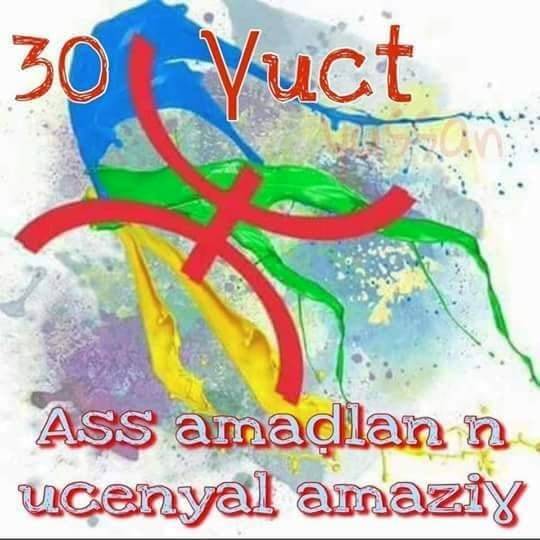
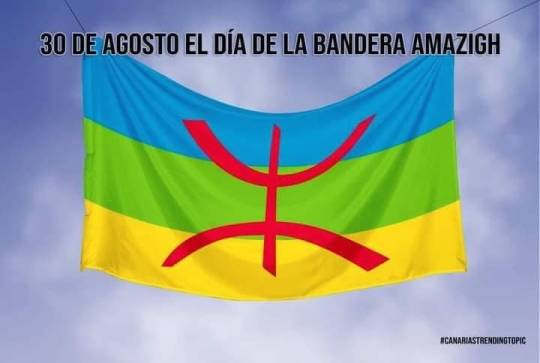
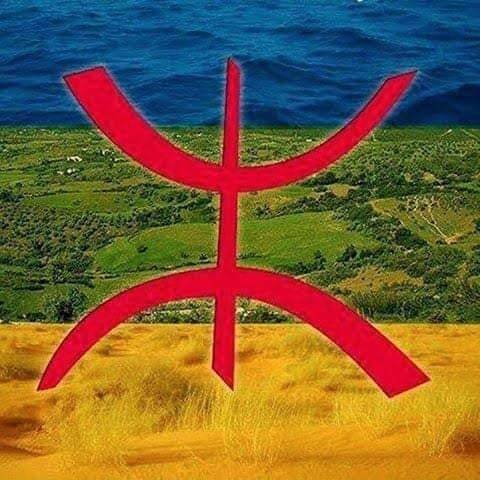
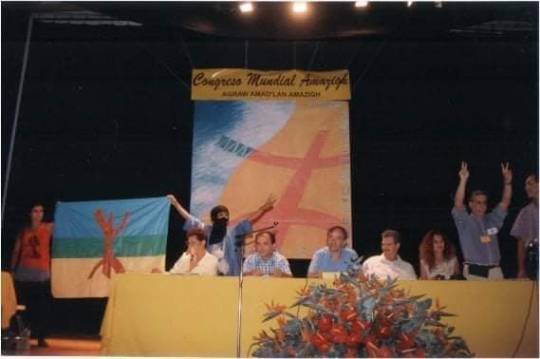

No dispongo de ningún enlace a esta publicación, desde que se tenga se publica los enlaces originales.
https://m.facebook.com/103032995459784/posts/pfbid0qYfKgRuV9WjsMmvN4acqs3eCV87bLA4QYq9nSMdKgYn1RT8iaGXAQycwraGKkmM4l/
#bandera amazigh#amazigh#culture#history#genocide#aborigenous#indigenous#unesco#international criminal court#cultura#historia#genocido#aborigenes#indigenas#tribunales internacionales de justicia#canary islands#canarias tiene identidad cultural propia#canarias libre#descolonizacion de canarias#canarias#cpi#icc#corte penal internacional#canarias la colonia mas antigua del mundo#onu#naciones unidas#islas canarias#united nations#ulpgc#las palmas de gran canaria
9 notes
·
View notes
Text
Writing systems
Neo-Tifinagh
The modern Tifinagh script is known as Neo-Tifinagh to distinguish it from the old Berber Script, and was reintroduced in the 20th century.
The Tifinagh script is thought to have derived from the old Berber script. “Tifinagh” possibly means “the Phoenician letters” or may come from the phrase tifin negh, which means “our invention”.
Notable features
Type of writing system: alphabet
Direction of writing: left to right in horizontal lines
Number of letters: 33 (without including conjunct consonants)
Used to write: Central Atlas Tamazight, Shilha, and Tamazight
Consonant gemination is represented by writing the letter twice. In order to avoid confusion with the -l-, the combination -nn- is written |/, and -ln- is written ||/.
Tifinagh uses Western punctuation, but some orthographies use tazarast, a punctuation mark, to indicate phrase and sentence breaks.
The old Berber script is an abjad, as it only marks vowels word-finally, but Neo-Tifinagh has letters for vowels as well.
Neo-Tifinagh alphabet

47 notes
·
View notes
Text
Books: Grammar of Tamazight: Central Atlas of Morocco
http://linguistlist.org/issues/30/30-1551.html?utm_source=dlvr.it&utm_medium=tumblr
0 notes
Text
Arabic - Who Speaks It and Where?
Arabic offers a blend of critical language skills and is useful in over 20 countries with around 300 million native speakers. There's no doubt that those who learn Arabic can live, work, and interact with a more diverse set of countries. As the Arabic saying goes, 'awwal alshshajarat bidharr (“A tree begins with a seed.”)
A trend can be seen in the private and non-profit sectors as businesses seek to better understand developing markets, and organizations work across borders to develop institutions, improve economies, and educate young people in the Middle East and North Africa. Yet the demand for Arabic-speaking professionals in most non-Arab countries exceeds the supply.
Read on to discover the countries where Arabic plays a key role.
Egypt
The official language of the Republic is Modern Standard Arabic. Arabic was adopted by the Egyptians after the Arab invasion of Egypt. The spoken languages are: Egyptian Arabic (68%), Sa'idi Arabic (29%), Eastern Egyptian Bedawi Arabic (1.6%), Sudanese Arabic (0.6%), Domari (0.3%), Nobiin (0.3%), Beja (0.1%), Siwi and others.
In Egypt, the colloquial expression for "How are you?" is "izzayyak".
Morocco
Morocco's official languages are Arabic and Berber. The country's distinctive group of Moroccan Arabic dialects is referred to as Darija. Approximately 89.8% of the whole population can communicate to some degree in Moroccan Arabic, or Maghrebi Arabic. The Berber language is spoken in three dialects (Tarifit, Tashelhit and Central Atlas Tamazight). In 2008, Frédéric Deroche estimated that there were 12 million Berber speakers, making up about 40% of the population. The 2004 population census reported that 28.1% of the population spoke Berber.
In Morocco, the colloquial expression for "How are you?" is '"la bas?"
Algeria
Berber and Modern Standard Arabic are the official languages. Algerian Arabic is the language used and understood by the majority of the population, and is also called locally ‘Arbiya or Dziriya. Algerian Arabic is part of the Maghrebi Arabic dialect, which fades into Moroccan Arabic and Tunisian Arabic along the respective borders.
Colloquial Algerian Arabic is heavily infused with borrowings from French and Berber. Algeria emerged as a bilingual state after 1962. Colloquial Algerian Arabic is spoken by about 72% of the population and Berber by 27–30%.
In Algeria, the colloquial expression for "How are you?" is "wac rak?"
Sudan
Approximately 70 languages are native to Sudan. Sudanese Arabic is the most widely spoken language in the country, an Afroasiatic language of the Semitic. The dialect has borrowed much vocabulary from local Nilo-Saharan languages (Nobiin, Fur, Zaghawa, Mabang). This has resulted in a variety of Arabic that is unique to Sudan, reflecting the way in which the country has been influenced by Nilotic, Arab, and western cultures. Few nomads in Sudan still have similar accents to the ones in Saudi Arabia.
In Sudan, the colloquial expression for "How are you?" is "Inta kwayes?" for a male and "Inta kwayes?" for a female.
Iraq
Arabic is the majority language; Kurdish is spoken by approximately 10–15% of the population; and Turkmen/Turkoman, the Neo-Aramaic language of the Assyrians and others, by 5%. Arabic, Kurdish, Persian, and Turkmen/Turkoman are written with versions of the Arabic script, the Neo-Aramaic languages in the Syriac script and Armenian is written in the Armenian script. Prior to the invasion in 2003, Arabic was the sole official language. Since the new Constitution of Iraq approved in June 2004, both Arabic and Kurdish are official languages.
In Iraq, the colloquial expression for "How are you?" is "Shlonak?" for a male and "Schlonech?" for a female.
Saudi Arabia
The official language of Saudi Arabia is Arabic. The three main regional variants spoken by Saudis are Hejazi Arabic (about 6 million speakers), Najdi Arabic (about 8 million speakers) and Gulf Arabic (about 0.2 million speakers). Saudi Sign Language is the principal language of the deaf community. The large expatriate communities also speak their own languages, the most numerous of which are Tagalog (700,000), Rohingya (400,000), Urdu (380,000), and Egyptian Arabic (300,000).
In Saudi, the colloquial expression for "How are you?" is "Keef halak?" for a male and "Keef halik?" for a female.
United Arab Emirates
The UAE is a Constitutional Federation of seven emirates: Abu Dhabi, Dubai, Sharjah, Ajman, Umm Al Quwain, Ras Al Khaimah and Fujairah, and Arabic (Emirati Arabic) is its the official and historical language. This is the language of the Emirati, with English as a second language. For example, most signs are in both Arabic and English e.g. road signs. The United Arab Emirates has a very diverse population, of which 10% are UAE nationals and the remainder is made up of expatriates.
In the UAE, the colloquial expression for "How are you?" is"shakhbaarak" for a male and "shakhbaarik" for a female.
Ready to learn Arabic? So, yallah, let's go.
0 notes
Text
Morocco guide: 10 things to know before you go
(CNN)Rainbows of color, spice-market smells, an urban orchestra of sounds: Morocco can be overwhelming at first.
Lying 13 kilometers, or 8 miles, from the coast of Spain, the North African country mixes Middle Eastern magic, Berber tradition and European flair.
Tourism has more than doubled since 2002, to nearly 10 million visitors in 2011. King Mohammed VI wants to increase the annual visitor numbers to 18 million by 2020.
The royal ruler's strategy is underpinned by infrastructure development, making traveling around the country even easier.
Add to this a program of ongoing social, political and economic reforms, and Morocco is one of the most moderate and peaceful countries in the region.
Here are 10 things you'll want to know before you arrive:
1. Cafes dominate life in Tangier.
Cafes are the key place to socialize, for Moroccan men at least. They gather to drink sweet mint tea and watch people as they go about their affairs.
The northern port city of Tangier has a history of literary bohemianism and illicit goings-on, thanks to its status as an International Zone from 1923 to 1956.
The Interzone years, and the heady decades that followed, saw writers, rock stars and eccentrics flock to the city's 800-plus cafs.
Two must-visit spots: Cafe Hafa (Ave Hadi Mohammed Tazi), overlooking the Strait of Gibraltar, was a favorite hangout of Tangier's most famous expat, writer and composer Paul Bowles.
Smoky and slightly edgy, Cafe Baba (1 rue Sidi-Hosni) is the coolest spot in the Kasbah. A photo of Keith Richards, kif-pipe in hand, still adorns the grimy walls.
Sea, souks and surfs in Morocco
2. Most mosques are off-limits to non-Muslims.
Nearly 99% of the population is Muslim, and hearing the muezzin's melodic call to prayer for the first time is a spine-tingling moment.
While very few Moroccan mosques are open to non-Muslims, one exception is the towering Hassan II Mosque in Casablanca (Blvd Sidi Mohammed Ben Abdallah; +212 522 22 25 63).
Located on a promontory over the Atlantic Ocean, the mosque was completed in 1993 and can hold 105,000 worshipers inside and out.
Tradition and technology sit side by side, with colorful zellij (mosaic tiles), intricate stucco and carved cedar complementing the retractable roof and heated flooring.
If you can't make it to Casa, Marrakech's 16th-century Ali ben Youssef madrassa-turned-museum (Pl Ben Youssef; +212 524 44 18 93) is open to all and also features impressive Islamic design.
3. Multilingual Moroccans will put you to shame.
Moroccans switch languages mid-sentence, reflecting the cultures -- Berber, Arab, French and Spanish -- that have crisscrossed the country.
Arabic is the official language, and you'll hear the Moroccan dialect, Darija, spoken on the street.
French continues to be widely spoken in cities; foreigners are often addressed in this first. Spanish is still spoken in Tangier.
There are also three main dialects spoken by the country's Berber majority: Tashelhit, Tamazight and Tarifit.
You'll be able to get by with English in the main tourist hubs, although "La, shukran" ("No, thank you" in Arabic) is one phrase to master.
4. Don't get stuck in Marrakesh.
Marrakesh is justifiably popular, but there's so much more.
Fez tops the list for its maze-like medina, fabulous foodie scene and annual Festival of World Sacred Music.
For a slice of the Sahara, there's the desert town of Merzouga, near the impressive Erg Chebbi sand dunes, accessible via camel treks.
Active types can hike between Berber villages in the High Atlas or head to the blue-hued Andalusian town of Chefchaouen to explore the Rif Mountains.
Beach bums will love laid-back Essaouira and Sidi Ifni on the Atlantic coast, while surfers often head south to Taghazout.
For quiet contemplation, Morocco's holiest town, Moulay Idriss, is hard to beat. Plus, you'll have the nearby Roman ruins of Volubilis pretty much to yourself.
The Atlas Mountains: Morocco's hidden travel gem
5. If you don't like cumin, you may starve.
Cumin is one of the main spices used in Moroccan cooking. This pungent powder is used to flavor everything from tagines to mechoui (slow-roasted lamb).
Cumin is used as a condiment on most Moroccan tables, along with salt and chili. It's also a popular natural remedy for diarrhea.
"Cumin has anti-parasitical properties, so if you've got an upset tummy, a spoonful of cumin knocked back with water will help," said food guide Gail Leonard with Plan-It Fez.
10 street foods to try in Morocco
6. Trains are cheap, comfortable and reliable.
Train company ONCF operates one of the best train networks in Africa, making it the easiest way to travel between cities.
It's worth paying extra for first class, which comes with a reserved seat and A/C.
First class carriages have six-seat compartments or open-plan seating. Stock up on snacks, or buy them onboard, as it's customary to share food.
When it comes to traveling to smaller towns and villages, buses and grand taxis, usually old Mercedes sedans that can seat six (at a squash), are best.
7. Couscous is served on Fridays.
You'll see it on every restaurant menu, but traditionally, couscous is served on Fridays, when families gather after prayers.
This is because the proper (not packet) stuff takes a long time to prepare.
Coarse semolina is hand-rolled into small granules to be steamed and fluffed three times. It's pale in color, deliciously creamy and served with vegetables and/or meat or fish.
Bread is the staple carb and is served with every meal, except couscous.
It's baked in communal wood-fired ovens, one of five amenities found in every neighborhood (the others being a hammam, or bathhouse; a drinking fountain; a mosque and a preschool).
8. Riad rooftops rock.
The traditional Moroccan house (riad) is built around a central courtyard with windows facing inwards for privacy.
They're decked out with elaborate zellij, stucco and painted cedar and are easily the most atmospheric places to stay.
While Moroccans tend to use their rooftops as clotheslines, a riad roof terrace is the place to be come sunset.
In Marrakech, Italian-designed Riad Joya (Derb El Hammam, Mouassine Quarter; +212 524 391 624; www.riadjoya.com) has prime views of the Koutoubia Mosque minaret, while five-star La Sultana (403 rue de la Kasbah; +212 524 388 008; http://ift.tt/2n3Umwo) overlooks the Atlas Mountains.
Top picks in Fez are the bohemian Riad Idrissy (13 Derb Idrissi, Sieje, Sidi Ahmed Chaoui, +212 649 191 410; www.riadidrissy.com) and its suntrap terrace, while Dar Roumana (30 Derb el Amer, Zkak Roumane; +212 535 741 637; www.darroumana.com) has sweeping views of the world's largest living medieval Islamic city.
9. When you hear 'balak!' watch out.
Morocco's souks are not for the faint-hearted. The narrow streets teem with hagglers, hustlers, mule-drivers and motor scooters.
Rule No. 1 is to step aside when you hear "Balak!" It means there's a heavily laden handcart or mule bearing down on you.
You'll inevitably get lost, as maps don't usually include the warren of small alleys that make up the medina.
A guide can help you get your bearings and fend off touts, but be aware that anything you buy will have his commission built in to the price.
Alternatively, taking snaps of landmarks with your smartphone can help you find your way back to your accommodation.
10. It's not weird to be bathed by a stranger.
There are plenty of posh hotel hammams, but nothing beats a visit to a no-frills public bathhouse.
Spotting the entrance can be tricky, as most signs are written in Arabic. Look for a shop selling toiletries or a mosque, as these are usually nearby.
It's advisable to stock up on black olive oil soap, ghassoul (clay used as hair conditioner), a kiis (exfoliating glove) and a mat to sit on. Visitors need to take their own towels, comb and flip-flops.
Women strip to their knickers (no bra), and men wear underpants. Then you'll be steamed, scrubbed and pummeled until you're squeaky clean.
23 best cities for street food across the world
More From this publisher : HERE
=> *********************************************** Original Post Here: Morocco guide: 10 things to know before you go ************************************ =>
Morocco guide: 10 things to know before you go was originally posted by A 18 MOA Top News from around
0 notes